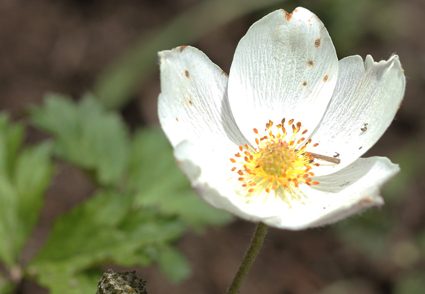Abstract
Based on consultation of literature, examination of herbarium specimens (including type material) and observations of living plants in the wild, we demonstrate that Anemone gonggaensis (Ranunculaceae), recently described from Kangding in western Sichuan, China, is not essentially different from A. rupicola (sometimes treated as Eriocapiitella rupicola), a morphologically very distinctive species widely distributed in the Sino-Himalayan region, including Bhutan, China (western Sichuan, southern and eastern Xizang, northwestern Yunnan), northern India, Kashmir, Nepal, Pakistan, and Sikkim. We therefore place both A. gonggaensis and E. rupicola in synonymy with A. rupicola herein.
References
- Anonymous (1972) Ranunculaceae. In: Iconographia Cormophytorum Sinicorum, vol. 1. Science Press, Beijing, pp. 651–753.
- Anonymous (2022) Ranunculaceae. In: Zhang, S.R. & Jiang, Y. (Eds.) Gongga Shan Weiguan Zhiwu Bendi Diaocha Baogao (“A Report of Exploration to the Vascular Plants of Gonga Shan”). Hubei Science & Technology Press, Wuhan, pp. 337–348.
- Christenhusz, M.J.M., Fay, M.F. & Byng, J.W. (2018) The Global Flora, Special Edition, GLOVAP Nomenclature Part 1, vol. 4. Plant Gateway Ltd., Bradford, 160 pp.
- Fang, M.Y. & Yang, M.Y. (1994) A study on pollen morphology and evolution of the genus Anemone from Sichuan. Journal of Sichuan University Natural Science Edition 31: 246–258.
- Finet, E.A. (1908) Additiones a la flore de l’Asie orientale (Renonculacées) (suite). Journal de Botanique 21: 29–34.
- Gogoi, R., Sherpa, N., Franklin, B.J.H., Agrawala, D.K., Rai, S.K. & Dash, S.S. (2021) Flora of Sikkim-A Pictorial Guide. Botanical Survey of India and Forest & Environment Department, Kolkata & Sikkim, 566 pp.
- Grierson, A.J.C. & Long, D.G. (1984) Anemone L. In: Grierson, A.J.C. & Long, D.G. (Eds.) Flora of Bhutan, vol. 1, part 2. Royal Botanical Garden, Edinburgh, pp. 291–294.
- Hooker, J.D. & Thomson, T. (1855) Anemone L. In: Flora Indica, vol. 1. W. Pamplin, London, pp. 19–25. https://doi.org/10.5962/bhl.title.50109
- Hoot, S.B., Meyer, K.M. & Manning, J.C. (2012) Phylogeny and reclassification of Anemone (Ranunculaceae), with an emphasis on austral species. Systematic Botany 37: 139–152. https://doi.org/10.1600/036364412X616729
- Huynh, K.L. (1970) Le pollen du genre Anemone et du genre Hepatica (Ranunculaceae) et leur taxonomie. Pollen Spores 12: 329–364.
- Jacquemont, V.V. (1841) Voyage dans l’Inde, vol. 4. Firmin Didot Frères, Paris, pp. 1–56.
- Janczewski, E.v. (1892) Études morphologiques sur le genere Anemone L. 1. Fruit et graine. Revue Générale de Botanique 4: 241–258.
- Juzepchuk, S.V. (1937) Anemone L. In: Komarov, V.L. (Ed.) Flora of the U.S.S.R., vol. 7. Nauka, Moscow & Leningrad, pp. 232–286.
- Kurita, M. (1957) Chromosome studies in Ranunculaceae I. Karyotypes of the subtribe Anemoninae. Reports of Biological Institute of Ehime University 1: 1–10.
- Li, L.Q. (1993) Anemone L. In: Wang, W.T. (Ed.) Vascular Plants of the Hengduan Mountains, vol. 1. Science Press, Beijing, pp. 506–516.
- Linnaeus, C. (1753) Species Plantarum. Laurentii Salvii, Holmiae, 1200 pp.
- Nakai, T. (1941) Eriocapitella, a new genus proposed for Anemone vitifolia group. The Journal of Japanese Botany 17: 263–272.
- Rau, M.A. (1993) Anemone L. In: Sharma, B.D., Balakrishnan, N.P. & Rao, R.R. (Eds.) Flora of India, vol. 1. Botanical Survey of India, Calcutta, pp. 27–41.
- Riedl, H. & Nasir, Y. (1991) Anemone L. In: Ali, S.I. & Nasir, Y.J. (Eds.) Flora of Pakistan, No.193. The National Herbarium & University of Karachi, Rawalpindi & Karachi, pp. 68–82.
- Tamura, M. (1967) Morphology, ecology, and phylogeny of the Ranunculaceae 7. Science Reports of Osaka University 16 (2): 21–43.
- Turczaninow, N. (1842) Flora baicalensi-dahurica seu descriptio plantarum in regionibus cis-et transbaicalensibus atque in Dahuria sponte nascentium. Bulletin de la Société Impériale des Naturalistes de Moscou 15: 1–796. https://doi.org/10.5962/bhl.title.6632
- Ulbrich, E. (1905) Über die systematische Gliederung und geographische Verbreiting der Gattung Anemone L. Botanische Jahrbücher für Systematik, Pflanzengeschichte und Pflanzengeographie 37: 172–256.
- Wang, W.T. (1974) Notulae de Ranunculaceis sinensibus III. Acta Phytotaxonomica Sinica 12: 155–180.
- Wang, W.T. (1980) Anemone L. In: Wang, W.T. (Ed.) Flora Reipublicae Popularis Sinicae, vol. 28. Science Press, Beijing, pp. 1–56.
- Wang, W.T. (1985) Anemone L. In: Wu, C.Y. (Ed.) Flora Xizangica, vol. 2. Science Press, Beijing, pp. 77–84.
- Wang, W.T. (2000) Anemone L. In: Wu, Z.Y. (Ed.) Flora Yunnanica, vol. 11. Science Press, Beijing, pp. 183–204.
- Wang, W.T. (2015) Notes on the genus Anemone (Ranunculaceae) of southwest China. Plant Diversity and Resources 37: 129–133.
- Wang, W.T. (2021) A new classification of Anemone (Ranunculaceae) of China. Guihaia 41 (supplement 1): 1–118.
- Wang, W.T. & Liu, B. (2016) Ranunculaceae. In: Wang, W.T. & Liu, B. (Eds.) Higher Plants of China in Colour, vol. 3. Science Press, Beijing, pp. 332–451.
- Wang, W.T., Ziman, S. & Dutton, B.E. (2001) Anemone Linnaeus. In: Wu, Z.Y., Raven, P.H. & Hong, D.Y. (Eds.) Flora of China, vol. 6. Science Press, Beijing & Missouri Botanical Garden Press, St. Louis, pp. 307–322.
- Xi, Y.Z. & Chang, K.T. (1964) Studies on pollen morphology of Anemone L. Acta Botanica Sinica 12: 19–38.
- Yonekura, K. (2008) Anemone L. In: Ohba, H., Iokawa, Y. & Sharma, L.R. (Eds.) Flora of Mustang, Nepal. Kodansha Scientific Ltd., Tokyo, pp. 82–86.
- Zhang, Y., Hong, Y., Ren, C., Tang, M., Hoot, S.B. & Yang, Q.E. (2015) Palynology, cytology, and molecular systematics of Anemone section Begoniifolia (Ranunculaceae). Plant Systematics and Evolution 301: 411–424. https://doi.org/10.1007/s00606-014-1082-0
- Ziman, S.N., Keener, C.S., Kadota, Y., Bulakh, E.V., Tsarenko, O. & Dutton, B.E. (2004) A taxonomic revision of Anemone L. subgenus Anemonantha (DC.) Juz. sensu lato (Ranunculaceae) III. The Journal of Japanese Botany 83: 281–310.
- Ziman, S.N., Bulakh, E.V., Kadota, Y. & Keener, C.S. (2008) Modern view on the taxonomy of the genus Anemone L. sensu stricto (Ranunculaceae). The Journal of Japanese Botany 83: 127–155.


